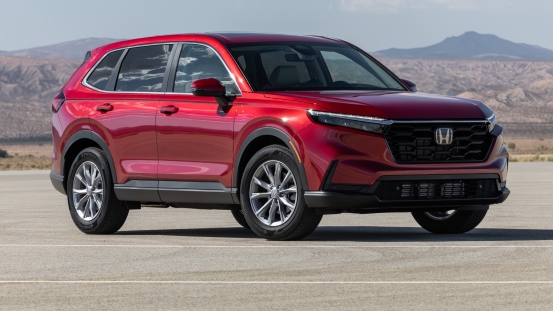The 2025 Honda CR-V continues to stand out in the compact SUV category, offering a well-balanced combination of versatility, comfort, and advanced technology. Available in trims ranging from the practical EX to the premium Sport Touring Hybrid, it delivers strong performance, refined design, and impressive efficiency—qualities that reinforce Honda’s long-standing reputation for reliability and thoughtful engineering.

Overview and Design
As an evolution of the sixth-generation CR-V introduced in 2023, the 2025 model retains its familiar silhouette while refining several key details. The front fascia now carries a more assertive grille, accented by sleek LED headlights and clean character lines that enhance its modern aesthetic. Inside, subtle updates to materials and digital functionality create a more sophisticated atmosphere.
Early owner feedback highlights the CR-V’s spaciousness, smooth ride, and intuitive technology. Many drivers appreciate its practicality and consistent reliability, though some note that the vehicle prioritizes comfort over sporty performance.
Performance and Powertrain
Honda continues to offer both gasoline and hybrid powertrains for the 2025 CR-V. The base engine is a 1.5-liter turbocharged four-cylinder that generates approximately 190 horsepower and 179 lb-ft of torque, paired with a continuously variable transmission (CVT). The hybrid option combines a 2.0-liter engine with two electric motors, producing around 204 horsepower. Front-wheel drive comes standard, while all-wheel drive remains available across most trims.
Driving impressions suggest the CR-V strikes a comfortable balance between power and efficiency. While not tuned for aggressive handling, it delivers predictable road manners and confident cornering. The hybrid variant earns praise for its seamless acceleration and responsive feel. Suspension calibration favors a smooth, stable ride over rough surfaces, and towing capabilities remain moderate—approximately 1,500 pounds for gas models and around 1,000 pounds for hybrids.
Interior Comfort and Space
The interior of the 2025 CR-V remains one of its strongest selling points. Rear passengers enjoy ample legroom—about 39 inches—ensuring comfort for long trips, while cargo volume stands at roughly 39 cubic feet with the rear seats up and expands to about 76 cubic feet when folded.
The cabin design follows a minimalist, horizontal layout. Standard trims feature a 7-inch digital cluster and infotainment display, while upper trims upgrade to a 9-inch touchscreen with enhanced connectivity. Higher-spec models include premium materials and additional soft-touch surfaces. Seating comfort is consistently praised, supported by generous adjustments and good bolstering. Improved cabin insulation also reduces road noise, providing a calm driving environment.
Fuel Efficiency and Economy
Fuel economy remains a strong advantage for the CR-V lineup. Gas-powered versions achieve approximately 28 mpg in the city, 34 mpg on the highway, and about 30 mpg combined for front-wheel drive. All-wheel drive variants post slightly lower results.
The hybrid model outperforms most competitors in efficiency, delivering around 43 mpg city, 36 mpg highway, and 40 mpg combined for front-wheel drive. All-wheel drive hybrids maintain around 40 mpg city and 37 mpg combined. Drivers report real-world fuel efficiency that aligns closely with EPA estimates, particularly in stop-and-go conditions where the hybrid system operates most effectively. The ability to drive short distances in electric-only mode adds to its city efficiency and eco-friendly appeal.
Competitive Comparison and Market Value
The 2025 Honda CR-V competes in a highly contested market segment that includes the Toyota RAV4, Mazda CX-5, Hyundai Tucson, and Ford Escape. Each model caters to distinct buyer priorities: the RAV4 for its dependability and powertrain range, the CX-5 for its premium feel and dynamic handling, the Tucson for its warranty and technology, and the Escape for its flexible engine lineup.
SUV Model | Starting MSRP (est.) | Key Strengths | Combined Fuel Economy |
2025 Honda CR-V | $28,500 – $39,000 | Reliability, interior space, efficiency | 30–40 mpg |
2025 Toyota RAV4 | $28,000 – $42,000 | Powertrain diversity, strong resale value | 30–41 mpg |
2025 Mazda CX-5 | $27,500 – $40,000 | Engaging drive, upscale interior | 26–28 mpg |
2025 Hyundai Tucson | $27,000 – $38,500 | Warranty coverage, modern tech features | 29–38 mpg |
2025 Ford Escape | $28,000 – $39,500 | Technology integration, engine options | 28–37 mpg |
(Figures are approximate and may vary by market. Buyers are advised to confirm with local dealerships.)
Honda’s reputation for longevity continues to benefit the CR-V’s resale performance. Historically, it retains value better than many competitors, with analysts predicting residual rates exceeding 60% after three years. This durability and market trust make the CR-V not only a dependable family SUV but also a sound long-term investment.
Final Thoughts
The 2025 Honda CR-V remains one of the most balanced compact SUVs on the market. With its refined design, efficient hybrid system, spacious cabin, and dependable performance, it successfully combines practicality with everyday comfort. For buyers seeking a vehicle that consistently delivers value, reliability, and efficiency, the latest CR-V continues to uphold Honda’s reputation as a segment leader.
